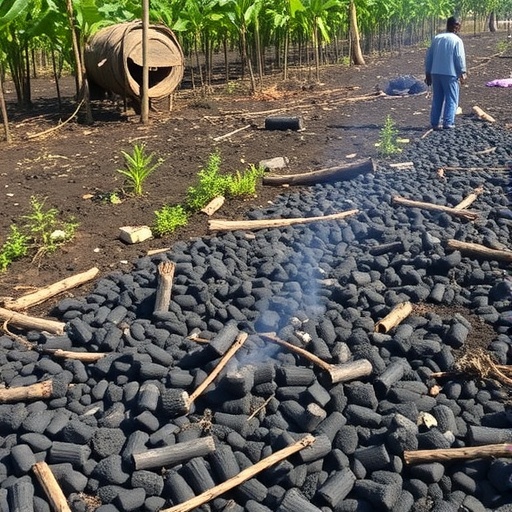In the picturesque tropical woodlands of southern Mozambique, the deep-rooted practice of charcoal production is intertwined with the daily lives of local communities, yet its impact on land cover changes remains a pressing environmental concern. This phenomenon has been intricately examined in the recent study by Mabutana, Molander, and Klintenberg, shedding light on the implications of charcoal production for both the environment and the socio-economic framework of the region. As the demand for charcoal rises, fueled by urbanization and consumption patterns, the balance between economic benefits and ecological sustainability hangs in the balance.
At the heart of this study lies the Combomune area, a region that epitomizes the delicate interplay between human activity and nature. Traditional charcoal production methods have long been a source of livelihood for many families, relying heavily on the abundant forest resources that grant them sustenance. However, the researchers reveal a troubling trend: the rapid conversion of forests into charcoal production sites contributes to land cover changes that could have dire consequences for biodiversity, soil integrity, and water resources. The study emphasizes the imperative need to assess these changes meticulously to avert potential ecological disasters.
The methodology employed by the researchers showcases innovative techniques for monitoring land cover changes using remote sensing data. By harnessing satellite imagery, the study meticulously maps alterations in land use over time, providing a comprehensive view of the ecological landscape. This analytical approach enables a high-resolution observation of woodland fragmentation, a key aspect of understanding the broader environmental impacts of charcoal production. Through this advanced technology, the researchers propose actionable insights for sustainable land management practices that can mitigate the adverse effects.
One critical finding from the research highlights the alarming rate at which woodlands are being cleared for charcoal production, underscoring how these activities disrupt local ecosystems. The researchers discuss that as trees are systematically felled, habitats for various species dwindle, leading to a decline in biodiversity that could take generations to recover. The cascading effects of this decline extend beyond flora and fauna; the soil becomes vulnerable to erosion, jeopardizing agricultural productivity and leading to further degradation of the landscape.
Moreover, the socio-economic dimensions of charcoal production are pivotal to understanding why such practices persist, despite the evident environmental cost. Many communities are heavily reliant on charcoal as a source of income, a fact that complicates the narrative of conservation. As urban areas grow, the demand for affordable energy sources, particularly charcoal, propels local residents to continue devastating forested areas, thus perpetuating the cycle of destruction. Addressing this issue requires not only ecological remedies but also socio-economic solutions that offer alternative livelihoods to these communities.
The study further explores the role of policy in regulating charcoal production. The researchers argue that current regulations are often inadequately enforced, leading to unauthorized logging and unsustainable practices. By delving into the nuances of existing policies, the study advocates for stronger governance frameworks that enforce sustainable practices while recognizing the needs of local populations. It is crucial for stakeholders, including governmental bodies and non-governmental organizations, to collaborate on education and awareness initiatives that promote responsible charcoal production.
A salient aspect of this research is its emphasis on community engagement in sustainable practices. As charismatic as the allure of charcoal production is, the study urges stakeholders to explore community-based initiatives that empower local voices in conservation efforts. By fostering a sense of ownership and stewardship, communities can become vital partners in preserving their environments while also enhancing their livelihoods. Such collaborative approaches have shown promise in other regions facing similar dilemmas, suggesting a pathway forward for Combomune and beyond.
As the environmental impact of charcoal production reverberates through various sectors, the research highlights the urgent need for innovation in the energy sector. The quest for alternative energy sources, such as solar or biomass, becomes increasingly urgent in mitigating dependence on charcoal. The researchers call out for investments in renewable energy technologies that can provide reliable alternatives while safeguarding the forest ecosystems that are integral to the region’s identity and ecological health.
In conclusion, the intricate web of land cover changes resulting from charcoal production in southern Mozambique illuminates the pressing need for comprehensive research and action. The findings of Mabutana, Molander, and Klintenberg serve as a clarion call for balancing economic necessity with ecological stewardship. As the global community grapples with similar challenges, this study serves as a poignant reminder that sustainable development must be predicated on an intimate understanding of local contexts and proactive collaboration among all stakeholders involved.
In light of these revelations, the future of Combomune’s woodlands and communities hangs in the balance, illuminating the broader implications for environmental management in regions where human livelihoods are directly reliant on natural resources. The imperative lies on society as a whole to forge pathways toward sustainable practices that ensure economic prosperity while cherishing the invaluable ecosystems that sustain life on our planet.
Subject of Research: Land cover changes due to charcoal production in southern Mozambique.
Article Title: Charcoal production in the tropical woodlands of southern Mozambique leads to land cover changes—the case of Combomune.
Article References:
Mabutana, S.T., Molander, S. & Klintenberg, P. Charcoal production in the tropical woodlands of southern Mozambique leads to land cover changes—the case of Combomune.
Environ Monit Assess 197, 1117 (2025). https://doi.org/10.1007/s10661-025-14514-4
Image Credits: AI Generated
DOI: 10.1007/s10661-025-14514-4
Keywords: Charcoal production, land cover changes, southern Mozambique, Combomune, sustainable practices, biodiversity, energy alternatives, community engagement.




